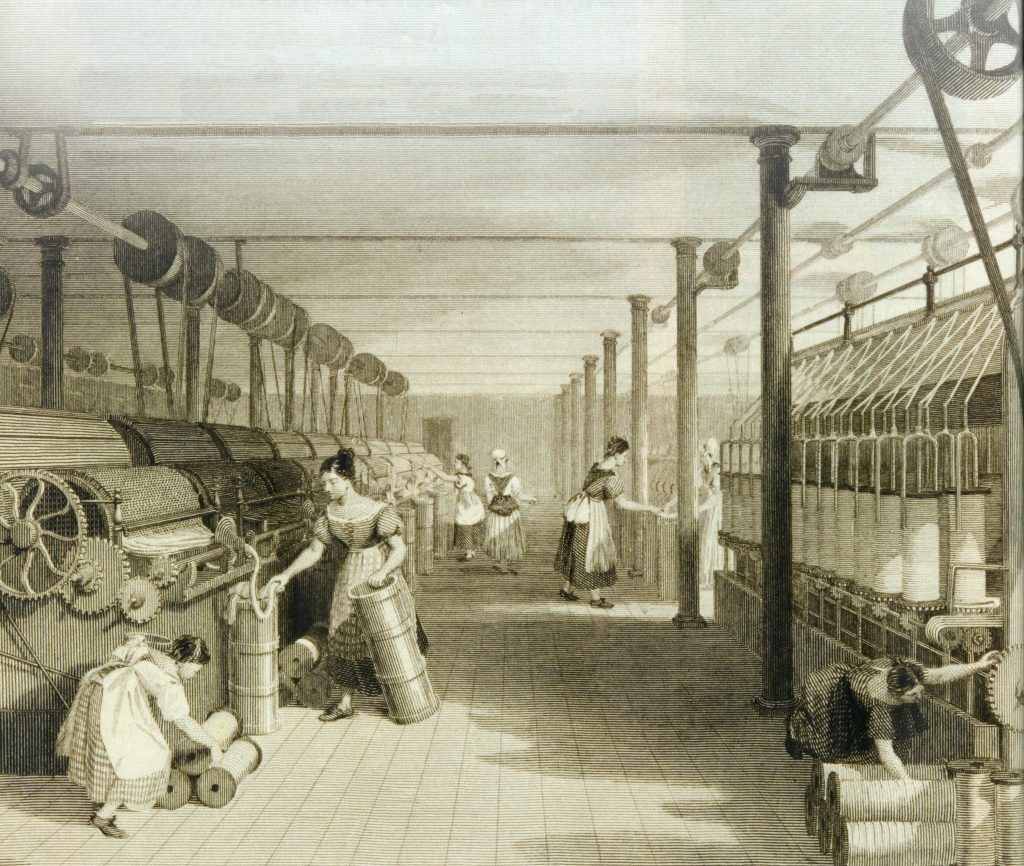Children today spend five days a week going to school for eight hours. During the first half of the nineteenth century in Britain, this was not the case. Instead, children even as young as five or six would toil all day long in factories or in mines. They had no breaks, no time off, and no schooling. Their work often led to horrible accidents, children being injured for life, and children left without an education.
Children laboring, of course, did not start with the British Industrial Revolution. It had been a normal part of life in Europe since the middle ages, when children helped their parents on farms and with household work. The people’s perception of this work, however, changed during the Industrial Revolution, since that is when people began to see this new kind of labor, factory labor, as an injustice and even criminal.1
The Industrial Revolution began in Britain during the 1780’s and rapidly changed the work process and the social relations of work. Prior to the Industrial Revolution, most people worked directly in the production of food, usually as farmers on their own farms. When textile factories began forming in the new factory cities, instead of working on their farms and making what their family needed, people left their farms and moved into the factory cities to make a living. Factory conditions of work, however, were far different from the work rhythms of farm life. In fact, they were brutal in comparison. Factory workers would typically put in between 12 and 16 hour days, working for meager wages. The machines they attended were dangerous, and the workers were often on their feet throughout the day, with perhaps a half-hour break for meals. Among these workers were children, many of whom were as young as five or six years old. Children were valued as workers for their small stature and ability to climb into small places and do things that adults often could not do. This often resulted in mutilation and the loss of appendages for many of these children.2
Children were also valued as workers by the factory owners because of the low wages that they were paid. Men were paid the most in factories, followed by women and then children. These wages, however small, were needed by the families of these children simply to survive. The parents often sent their children out to work to help pay for rent, food, and otherwise help make ends meet.3
One reason that the British public became outraged by child labor practices was the fact that children in factories were not receiving an education. Horace Mann, an American educational reformer, stated:
No greater calamity can befall us as a nation than that our children should grow up without knowledge and cultivation. If we do not prepare them to become good citizens, develop their capacities, enrich their minds with knowledge, imbue their hearts with a love of truth and all things holy, then our republic must go down to destruction as others have gone before it.4
This represents the thoughts of the British at the time, which was being echoed in the United States during its own industrial revolution. People wanted to ensure the future of their nation, which starts with the young. They believed that children should attend school for at least a while.5 This led to several laws being passed to raise the legal age of work.
In 1833, the British Parliament passed the Regulation of Child Labor law to help improve the working conditions for children in factories. The Law limited the age of workers, saying that they had to be older than nine with an age certificate to prove it, and that children 9-13 could not work for more than nine hours a day. Additionally, children 13-18 were not permitted to work longer than twelve hours a day. Along with these work-hour restrictions, the law also made school attendance a two-hour requirement, and said that children could not work at night. Fines for breaking these rules were small, however, so they were frequently violated, often with impunity.6

Many other pieces of legislation were also passed to place limits on the gender, hours, and ages of workers. The Mining Act of 1842 prevented women and girls from working in mines, and the Ten Hours Bill of 1847 set ten as the maximum number of daily working hours for women and children. This act was hated by factory owners because they believed it would hurt the textile industry’s competitiveness worldwide. After these bills, others followed to ensure their effectiveness, and to ensure that they would be properly implemented.7
By 1900, the minimum working age had been raised to twelve years of age and child labor had decreased drastically in Great Britain. However, the introduction of legislation against child labor provoked its share of protests as well. Because of these protests, Parliament established commissions to collect evidence of abusive practices. These were called the Blue Books or Sadler Reports. They interviewed children, parents, factory workers, owners, and even doctors on the condition of children in textile factories. Unsurprisingly, the reports uncovered a range of serious abuses by factory owners and overseers. Unfortunately, most critics just said that the claims were exaggerated in order to continue their money making practices.8
The legislation surrounding the British Industrial Revolution had become very effective by 1900, and child labor and its accompanying abuses had decreased dramatically. By 1900, most children were attending school instead of working in factories. The laws passed finally added up to changing British child labor to being closer to what we see today, a mostly child-free labor system, with children going to school and adults having regulated working hours.
- World History Encyclopedia, 2011, s.v. “Child Labor and Child Labor Laws in Early Industrial Great Britain.” ↵
- James D. Schmidt, “Broken Promises: Child Labor and Industrial Violence,” Insights on Law & Society, no. 3 (Spring 2010): 14–17. ↵
- Robert Whaples, “Hard at Work in Factories and Mines: The Economics of Child Labor during the British Industrial Revolution,” Business History Review, no. 2 (2001): 429. ↵
- Friends’ Intelligencer vol. 28 no. 1 (1871): 336. ↵
- James D. Schmidt, “Broken Promises: Child Labor and Industrial Violence,” Insights on Law & Society, no. 3 (Spring 2010), 14–17. ↵
- Great Britain, “Factories Regulation Act” (1833). ↵
- Steven Toms and Alice Shepherd, “Creative Accounting in the British Industrial Revolution: Cotton Manufacturers and the ‘Ten Hours’ Movement,” MPRA Paper, No. 51478 (2013), 6-8. ↵
- World History Encyclopedia, 2011, s.v. “Child Labor and Child Labor Laws in Early Industrial Great Britain.” ↵



141 comments
Claire Saldana
The article gave a quick glimpse into the world of child labor. I like to watch movies from this time period however, every single one has the aspect of children having to work to support their families. I can’t imagine what it would be like if we had never had these laws come into place. Education is very important for all children and our futures and while we don’t see child labor in the U.S. it is happening in other countries. A child should not have to be forced to work in poor conditions they need to learn and play.
Mauricio Rebaza Figueroa
I think this article explained really well made with a big amount of information that can make you realize how lucky you are not to suffer these conditions child workers had to go through during Industrial Revolution all around the world because of how deregulated was the labor space. Good use of images and sources that make this article trustable. Good job.
Vianne Beltran
Hi Bailey,
I enjoyed your article and the info I learned. It really highlighted the importance the Industrial Revolution had on other areas besides new technology. Besides changing how people received manufactured goods it also changed how employment was viewed. Without the Industrial Revolution the significance of children’s education might have been considered much later. Your article did a good job of explaining how the Revolution influenced multiple aspects of British life.
Carlos Hinojosa
It’s quite sad how desperate some people were at the time to the point they would send their own kids to risk their bodies just to pay rent. It’s also sad that these factory owners could care less if they were children and instead were happy that they were so it could be easier to spend less money on wages. I hope most countries these days will stay away from this horrible practice as to many children will either die or become horribly maimed. Very good article and I hope to read more.
Gisselle Baltazar-Salinas
This article does a great job explaining the labor system of England before the 1900’s. I had briefly of England”s child labor before this article. From the sounds of it I had much I did not know. I find it most saddening that people only cared about money instead of some kid that doesn’t have education. I am a huge advocate for education being important to the well being and benefits of the world and country.
Katelyn Canales
Hello Ms. Rider,
I really enjoyed reading your article. First off I wanted to say an excellent job on your choice of words in the title. I think it really grasps the concept of just how bad these labor systems were for children. It is very sad to hear that they were forced to go hours without a break, no time off, or schooling. I liked how you tied in the reforms that saved these children’s lives, and gave the reader very valuable information on what happened in Great Britian once the child labor stopped. The images you chose really made me feel like I was there, it gave me a visual image of what life could be like going to work everyday as a child. Thank you for reminding us about this part of history most tend to forget. I am a huge advocate for children, and I am glad these unlawful actions towards them were stopped.
Phylisha Liscano
This was a well written article and very interesting . I had very little knowledge of the labor system of England. It’s sad that people cared more about money instead of the children. Before reading but I enjoyed getting the chance to read more about it. Taking a look I can tell lots of research was put into your article and you provided lots of information. Overall great article and an excellent topic.
Madison Goza
Your article was such a fascinating read! I liked how you opened your article by contrasting the everyday lives of kids in today’s world with children working in British factories during the Industrial Age. I was horrified to learn that such young children endured such awful working conditions. Overall, your explanation of this subject was very thorough and straightforward, and you really captured the need for labor regulation and reform during this time period. Great job!
Kanum Parker
This article does a great job explaining the labor system of England before the 1900’s. I haven’t heard much of Englands child labor before this article but from the sounds of it I could assume it was just like the American child labor system. Its is sad that people only cared about money instead of some kid that doesn’t have education.Education is important so I am glad the laws were made for the sake of the kids.
Kanum Parker
This article does a great job explaining the labor system of England before the 1900’s. I haven’t heard much of Englands child labor before this article but from the sounds of it I could assume it was just like the American child labor system. Its is sad that people only cared about money instead of some kid that doesn’t have education.Education is important so I am glad the laws were made for the sake of the kids.